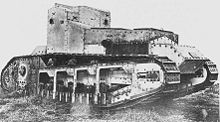Nämä vaunut osallistuivat 1918 ensimmäistä kertaa taisteluun saksalaisia vastaan.
Whippet vaunuja käytti myös Muurmanskiin ja Estoniaan maihin nousseet liittoutuneiden joukot joilla oli 19 whippet vaunua.
Kaikki nämä 19 kpl vaunut jäivät puna-armeijan saaliiksi.
Etelä-Venäjällä maihin nousseilla joukoilla jotka tukivat Kenraali Denikin valkoisten joukkojen armeijaa oli käytössä 17 vaunua ja Argangelissa 2 vaunua.
Vaunuissa oli Taylor moottorit, ja puna-armeijassa ne tunnettiin Taylor vaunuina.
Medium-A vaunua muistuttanut neuvosto - panssarivaunu, T-12, jäi prototyypiksi
(valmistui 1928-1929 aikana). Monet muut neuvostoliiton panssarivaunut saivat
paljon piirteitä tästä Medium-A mallin vaunusta.

Whippet painoi 15,7 tonnia, panssaroinnin vahvuus oli 5-14 mm, nopeus 12 km/h
joka oli tuohon aikaan huomattavan suuri, vaunujen moottorit oli edessä, takaosassa kiinteä nelikulmainen torni jonka aseistuksena oli 4 konekivääriä, yksi joka sivulla. Polttoainesäiliö, jäähdyttimet ja moottorit oli sijoitettu vaunun etuosaan.
Kaksi Taylor-moottoria oli asennettu rinnakkain vaunun runkoon, ennen tornia ja kumpaakin telastoa varten oli oma moottori, ratkaisu heikensi ohjauksen toimivuutta.
Miehistönä oli kolme miestä, myöhemmin vaunuista yksi konekivääri poistettiin lisä-tilan saamiseksi torniin.
-----------------------------------------------------------------------------------------------------------
(Allempires com)
Type: Medium tank
Place of origin: United Kingdom
In service: 1918-1930s
Designer: William Tritton
Manufacturer: Fosters of Lincoln
Produced: 1917-1918
Number built: 200 by 14 March 1919
Weight: 14 t
Length: 6.10 m (20 ft)
Width: 2.62 m (8 ft 7 in)
Height: 2.75 m (9 ft)
Crew: 3
Armour: 14 mm
Main armament: 4 × 0.303 inch Hotchkiss machine guns
Secondary armament: none
Engine:2× Tylor Twin 4-cylinder side-valve JB4 petrol engine
2x 45 hp (67 kW)[
Power/weight: 6.4 hp/tonne
Transmission: 4 forward speeds and 1 reverse
Suspension: unsprung
Speed: 13.4 km/h (8.3 mph)
------------------------------------------------------------------------------------------------------------------------
The Medium Mark A Whippet was a British tank of World War I. It was intended to complement the slower British heavy tanks by using its relative mobility and speed in exploiting any break in the enemy lines. Whippets later took part in several of the British Army's postwar actions, notably in Ireland, North Russia and Northeast China.

This armoured fighting vehicle was intended for fast mobile assaults. Although the track design appears more "modern" than the British Tanks Mark I to V, it was directly derived from Little Willie, the first tank prototype, and was unsprung. The crew compartment was a fixed, polygonal turret at the rear of the vehicle, and two engines of the type used in contemporary double-decker buses were in a forward compartment, driving one track each.
When driving in a straight line the two engines were locked; turning the steering wheel gradually closed the throttle for the engine of one track and opened the throttle for the engine driving the other.
The two engines were joined at their cross-shafts, from which the final drive to the tracks was by chains to sprockets on either side. When steering the clutches joining the cross-shafts were released, one engine sped up while the other slowed down, the turn being on the side opposite to that of the faster running engine.
The steering effect could be increased by use of the brakes on one engine or another. This arrangement had the advantage over that of earlier tanks of being controlled by one man only, but called for great skill on the part of the driver, because one or both of the engines could be stalled if care was not exercised.

Although in theory a simple solution to give gradual steering, in practice it proved impossible to control the speeds of the engines, causing the vehicle to take an unpredictable path. Drivers grew wary and stopped the vehicle and locked one track before every turn; this caused many track breaks, as the movement became too abrupt.
The fuel tank was in the front of the hull. The sides featured large mud chutes which allowed mud falling from the upper treads to slide away from the tank, instead of clogging the track plates and rollers.
Armament was four 0.303 in Hotchkiss Mk 1 machine guns, one covering each direction. As there were only three crewmen, the gunner had to jump around a lot, though often assisted by the commander. Sometimes a second gunner was carried in the limited space, and often a machine gun was removed to give more room, as the machine guns could be moved from one mounting position to another to cover all sides.

Major Philip Johnson, the unofficial head of Central Tank Corps Workshops in France, as soon as he received them began fitting one of the Whippets with leaf springs.
Later, in 1918, he fitted this vehicle with sprung track rollers, Walter Gordon Wilson's epicyclical transmission from the Mark V and a 360 hp V12 Rolls-Royce Eagle aero-engine. A top speed of about 30 mph (48 km/h) was reached.
This project made Johnson the best qualified man to develop the later fast Medium Mark D, which looks like a reversed Medium A. Other experiments included the fitting of a large trailing wheel taken from an old Mark I tank and attaching a climbing tail, in both cases attempts to increase trench-crossing ability.
For a time it was assumed that after the war some Whippets were rebuilt as armoured recovery vehicles, but this was not the case.
The Medium Mark B, a completely different design by Wilson, also had the name "Whippet". For a time it was common to describe any of the lighter tank designs as a Whippet, even the French Renault FT. It had become a generic name.
Nice looking pictures, I like the ancient tanks...very interesting!
VastaaPoistaGood morning Phil.
Poista:)
Thank you for your comment.